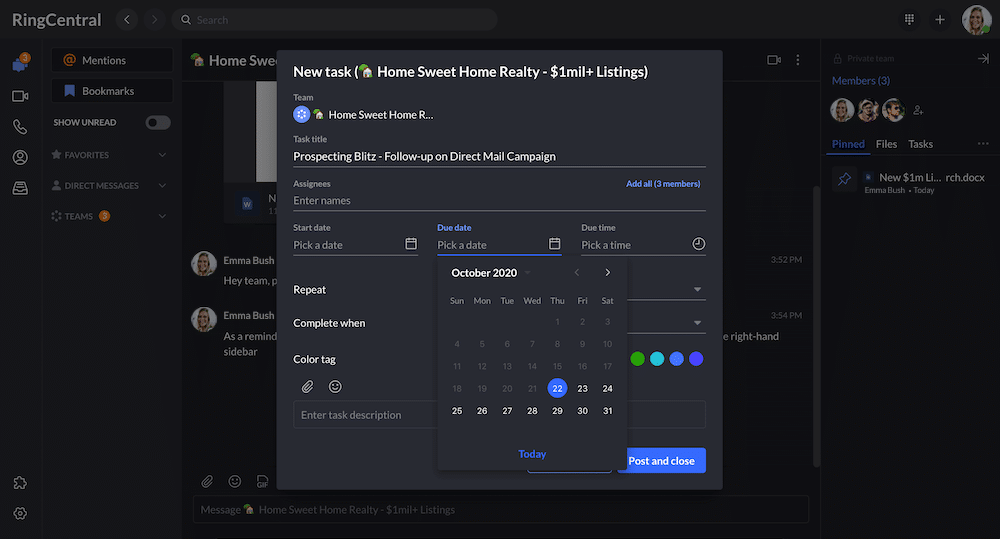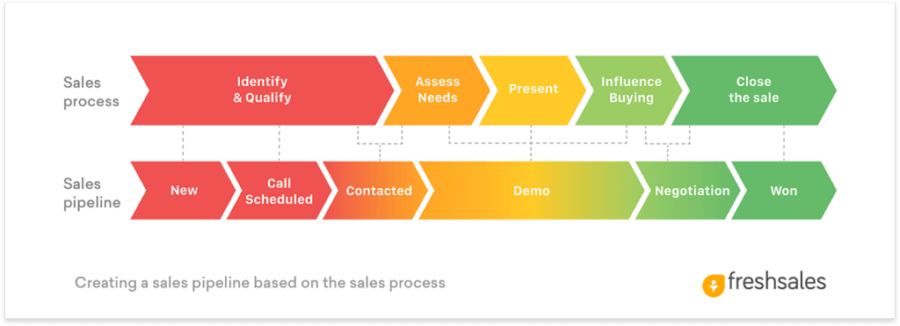Disjointed team meetings. Vetting leads. Maintaining customer relationships. These are all common challenges sales teams encounter regularly. And if left unaddressed, sales and morale can plateau—or worse—drastically decline.
So what should a sales team do?
Healthy sales collaboration is the key to fixing sales slumps or team issues. By focusing on collaboration, your team can unravel problems and make room for more wins.
In this post, we cover:
- The anatomy of a sales team
- What does sales collaboration look like?
- 3 ways your team can start selling more—together
Up your sales productivity game and close more deals with these free cold outreach scripts. ☎️
The anatomy of a sales team
Sales teams come in all shapes and sizes. The question is, what structure is best for your business?
Industry, product, and demand are three significant factors that influence a sales organization’s structure—that, and the resources available, like funding, to a business. As a result, sales teams can get complicated quickly, no matter the size of your company.
For a sales team to be successful and to collaborate well, it’s important to understand how a sales team is supposed to function. If sales reps are confused about their role or responsibilities, it can cause core problems that impact your business’s bottom line, customer relationships, and more.
Let’s break down the most common roles found across sales organizations. Keep in mind that depending on your company’s size, some of these roles may be blended.
Account executive
The role of an account executive (AE) is the core of any strong sales organization. AEs are responsible for managing relationships with customers and closing deals with new customers. Think of AEs as a sales team’s worker bees.
Sales development representative
Sales development representatives are responsible for lead generation and scouting high-quality prospects rather than closing deals. Depending on the size of your company, this role may be combined with the account executive role.
Hiring manager
This role speaks for itself; hiring managers oversee the hiring process. They look for certain traits, experience, and qualities in candidates to help managers and directors build prosperous teams. This is another role that may default to your sales director or manager if your team is on the smaller side.
Customer service representative
Another straightforward yet critical role for not just a strong sales team but a strong company, in general, is the role of a customer service representative. Customer service representatives are responsible for keeping customers or clients happy. They help with a variety of tasks, from handling customer complaints and issues to providing customers with things like product and service information.
Account director or sales director
Account directors oversee the team as a whole. They are responsible for making sure every member of the team is on target to meet goals and that everyone has the resources they need to do their best work.
Sales trainer
The role of a sales trainer is arguably just as important as account executives or customer service representatives. For your team to move forward, grow, and learn new skills, they must have the proper training. Sales trainers ensure the team as a whole is getting the education and coaching they need to succeed in their role on the sales team.
As we mentioned earlier, this structure isn’t rigid and typically looks different depending on your company size and industry. However, it’s vital to make sure these responsibilities are filled in some capacity. Each of these six roles holds a unique value that, when collaborating properly together, creates a high-functioning team.
What does sales collaboration look like?
Collaborative selling starts with a team that’s on the same page from top to bottom.
We’ve covered the basics of what a typical sales team entails. Now, let’s look at what makes for a collaborative sales team.
Emphasis on continuous learning
In the sales world, a major part of growing and consistently producing high results involves continuous learning. Sales reps that are naturally curious and want to learn ways in which they can up their performance will ultimately make for a successful team.
Sales teams that focus on education see improvements across performance, such as:
- Finding solutions to problems quicker
- Understanding their customer’s point of view on a holistic level
- Sharpening their skills
- Improving their product knowledge
Best of all, there are many ways sales teams can build their skills for the long-term. Exercises like role-playing sales situations, listening as more senior members handle customer interactions, and more help teams build confidence and expertise.
Goal alignment
A key part of any thriving, collaborative sales team is well-defined, tangible goals. Without goals and targets, it will be difficult for teams to understand what they’re working towards as well as how they should be spending their time.
Setting goals can be daunting, but it’s mission-critical. To set goals, consider the SMART framework:
- Specific: Ask your team questions like, “What are we trying to accomplish?” “Why is this important?” These questions will help you get as specific as possible. If you have a clear goal, it’ll be easier to develop steps to achieve it.
- Measurable: Establishing measurable goals will help your team track your progress and make adjustments accordingly.
- Achievable: Goals must be attainable. While it’s great to shoot for the moon, setting unreachable goals will set your team up for failure and frustration.
- Relevant: Make sure your goals are not only relevant to sales but also coincide with other goals as well. Goals can build off one another.
- Timely: Lastly, create a timeline for your goals. This keeps your team on track and helps you break your goals into phases, which can reduce overwhelm.
Superb communication skills
A crucial component of a collaborative team is excellent communication. Without communication, it will be challenging to be productive or to get anything done. Especially with so many teams working remotely for the foreseeable future, having a solid communications system is essential to success.
I engage lots of different sales engineers depending on the complexity of the deal, for example. Sometimes I’ll get mom and pop shop types of customers, like five users, which is easy-peasy. Other times I’ll get a car dealership with six locations across four states, and they need paging systems and a whole lot of other fancy features. These ones, I need to collaborate a lot on!
Things can get complicated quickly depending on the nature of your potential customer’s business. That makes excellent communication and collaboration skills all the most important.
But as a distributed team, how can you best connect with your coworkers? Communication solutions, like the RingCentral app, keep the team connected no matter where you’re working. My team talks to each other in many different ways. Some people prefer video conferencing, others like to message each other instead. And no matter what we prefer, we can also use the same app, which helps keep all our files and tasks in one place:

It’s great to be able to sell a product that I use every single day. 😉
It also helps that there are some genuinely unique and useful features in the RingCentral app that helps me in my day-to-day sales work. For instance, if I’m on a call with a potential client in the evening but I need to take my kid to practice, I can flip the call from my computer to my cell phone without interrupting the conversation so I can continue chatting away from my desk:

Lean on processes
To be a truly collaborative (and productive!) sales team, you need to have processes in place. Processes make sure the entire team is on the same page and is following the correct protocol for maximum efficiency.
Processes help teams avoid duplicate work, missing tasks, and miscommunication. For sales teams specifically, this means creating a sales process:

What are the steps you take to move customers down the sales funnel (learn more about those here)?
A sales process can also help your team identify areas for more efficient selling and consistency for both your customers and the team.
3 ways your team can start selling more efficiently, together
1. Use the right sales collaboration tools
The right collaboration tools for sales set your team up for long-term success, not just with reaching goals but with your customers, too. Remember, more tools doesn’t mean more productivity. In fact, it can be the opposite.
That’s why choosing a sales collaboration tool that connects your team in various ways in a single platform can take your productivity and sales to new heights.
See how Triumph Motorcycles, for example, used a sales collaboration tool to connect over a hundred dealers across the country. (The performance killer they had to get rid of? An outdated phone system.)
One particular quote that I enjoyed (from the above Triumph Motorcycles case study) is this one: “It wasn’t until we started talking with RingCentral that we realized how much we could also benefit from additional services built into the system like SMS, electronic fax, online meetings, a mobile app, and other communication services.” This was from Brandon Keller, the Operations Manager at Triumph Motorcycles. “The RingCentral team actually showed us ways we could improve our efficiency and collaboration that we didn’t even know about.”
It’s a perfect testament to the benefits of switching to an all-in-one communications tool, especially if you’re a distributed or hybrid team that’s juggling timezones.
2. Lean on the individual strengths of your sales reps
Not all of your team members share the same strengths and weaknesses. Where one team member falls short, another may be able to make up for it. That’s the makings of a sales team that can do it all.
Typically, when I get a lead, the first thing I do is reach out to a partner, then I do a great deal of discovery (it’s the most important step of the process for me), and then we get on a call to dig into the questions even more.
Are we looking at someone who wants our office product or contact center? Because there are different engineers I would need for both. Do they want custom integrations? That’s another engineer. A complex demo that’s outside of my wheelhouse? I’ll pull an engineer in to help with the demo.
Play to the strengths of your team and watch the wins pile up.
3. Find solutions to common customer objections
Every business, no matter the industry, size, or products and services offered, experiences customer objections—or roadblocks that prevent customers from purchasing. Understanding your company’s unique objections is one of the best ways to improve your sales numbers.
There are several ways your sales team can approach finding these objections:
- Ask your customers why they decided not to buy.
- Audit your website and make sure the language and visuals are clear.
- Mine product reviews for recurring negative feedback.
- Send feedback forms or surveys to customers who did purchase so you can always be improving.
Knowing what’s preventing customers from purchasing is one thing, but it’s another to work together as a team to overcome these objections. Once you have a clear understanding of what your team needs to focus on, make a plan, and start breaking down these roadblocks together.
Teamwork really does make the (sales) dream work
Successful sales collaboration is founded on teams working together toward a shared goal. Without effort from the entire team, it will be an uphill battle to do so.
Improving how your team collaborates, paired with a cloud-based communication tool, will streamline productivity and drive more sales.
How does your sales team collaborate to achieve goals?
Originally published Jan 04, 2021, updated Feb 22, 2021





